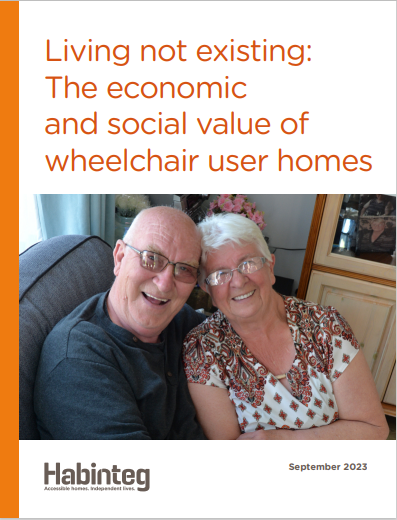Talk to us 0300 365 3100

Talk to us 0300 365 3100
Talk to us 0300 365 3100

New research has revealed that building more wheelchair user homes for disabled people, from children to adults over 66, could save the public purse millions over a 10 year period.
In research commissioned by Habinteg Housing Association, the London School of Economics (LSE) and Political Science Housing and Communities research group interviewed people from three household types and analysed publicly available data to discover the value to society and the economy of building new wheelchair user homes.
The research report, entitled Living not existing: The economic and social value of wheelchair user homes, revealed that the additional cost of building a wheelchair user home – instead of an accessible & adaptable home 1 - for a typical disabled adult of working age is around £22,000, with the potential ten-year financial and social benefit to the individual and the public purse being around £94,000.
For a household with a child who is a wheelchair user, the ten-year economic and social benefit is around £66,000, with an additional cost of around £26,000 to build a new wheelchair user home.
For a typical older wheelchair user household, the ten-year financial and social benefit is around £101,000, with a new wheelchair user home costing around an additional £18,000.
The positive impact on the public purse for each household type benefits both national and local bodies. For local authorities, savings amount to around: £1,700 per year for a household with a disabled child; £4,800 for a household of working age, and £9,200 for a later year’s household. The NHS also benefits by hundreds of pounds, per household, per year.
Meanwhile, savings to government through tax, national insurance and a reduced welfare spend is £700 for a household with a disabled child, and £2,400 for a working age adult household (£0 for later years’ households).
New wheelchair accessible properties (known as M4(3) in building regulations) are built when Local Plans set a target within their housing policies. At present, of England’s 324 Local Plans, 162 have no target included for such homes.
Habinteg’s CEO, Nick Apetroaie, said: “This new research reveals a clear and powerful economic case for wheelchair accessible homes that must not be ignored. Behind the numbers we must not forget that the shortage of wheelchair accessible properties has a profound negative impact on people’s daily lives. It’s not acceptable for society to expect wheelchair users and their families to ‘make do’ in homes which limit their independence, dignity and overall life opportunities.
“We’re calling on the government and relevant agencies to set a clear requirement for every local authority to create a robust plan for new wheelchair accessible homes. Without this we will be literally building inequality into housing stock, not only at great personal cost to individuals and households, but also - in the medium to long term - to the public purse, too.”
The research identifies eight key social benefit areas that new wheelchair user homes can bring to individuals and society, as well as the government and NHS. The top four being:
Interviewees talked about living rather than existing once in a home that was accessible and met their needs. For young adult wheelchair users, a wheelchair user home can also support their transition out of the family home and into an independent life.
One working age interviewee in his 20s, Joe (a pseudonym) spoke of how moving out of his parents’ home, into a wheelchair user home, increased his independence and self-esteem.
“It's fantastic and it's been fantastic since I've moved in it… it enables me to live independently… to work and live my life… I'm sure that if I was still living at home in my 30s, much as I love my parents, I wouldn't see a future and beyond living with them,” he said.
“I've always been very grateful that I'm in a job because I know that I probably wouldn't be able to afford the mortgage if I weren't in a job. I don't think benefits would be enough to cover it,” he added.
LSE Visiting Senior Policy Fellow, Dr Bert Provan, said: “ Our research shows that setting a minimum level of building of new homes to meet the needs of wheelchair users would bring life enhancing benefits to individual lives, as well as potential savings to the public purse."
As a result of this report, Habinteg is calling on government to:
Read Habinteg's summary report, Living not existing: The economic and social value of wheelchair user homes.
Notes to Editors
The full report into the social and economic value of wheelchair user housing is available for download on the London School of Economics and Political Science website.